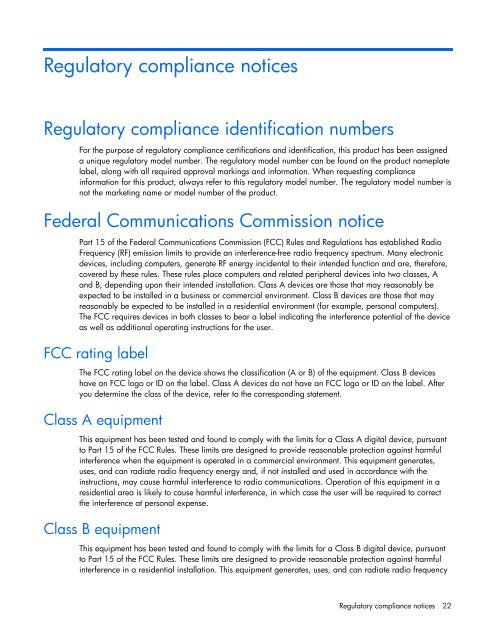HP TFT7600 Rackmount Keyboard and Monitor User Guide
HP TFT7600 Rackmount Keyboard and Monitor User Guide
HP TFT7600 Rackmount Keyboard and Monitor User Guide
Create successful ePaper yourself
Turn your PDF publications into a flip-book with our unique Google optimized e-Paper software.
Regulatory compliance notices<br />
Regulatory compliance identification numbers<br />
For the purpose of regulatory compliance certifications <strong>and</strong> identification, this product has been assigned<br />
a unique regulatory model number. The regulatory model number can be found on the product nameplate<br />
label, along with all required approval markings <strong>and</strong> information. When requesting compliance<br />
information for this product, always refer to this regulatory model number. The regulatory model number is<br />
not the marketing name or model number of the product.<br />
Federal Communications Commission notice<br />
Part 15 of the Federal Communications Commission (FCC) Rules <strong>and</strong> Regulations has established Radio<br />
Frequency (RF) emission limits to provide an interference-free radio frequency spectrum. Many electronic<br />
devices, including computers, generate RF energy incidental to their intended function <strong>and</strong> are, therefore,<br />
covered by these rules. These rules place computers <strong>and</strong> related peripheral devices into two classes, A<br />
<strong>and</strong> B, depending upon their intended installation. Class A devices are those that may reasonably be<br />
expected to be installed in a business or commercial environment. Class B devices are those that may<br />
reasonably be expected to be installed in a residential environment (for example, personal computers).<br />
The FCC requires devices in both classes to bear a label indicating the interference potential of the device<br />
as well as additional operating instructions for the user.<br />
FCC rating label<br />
The FCC rating label on the device shows the classification (A or B) of the equipment. Class B devices<br />
have an FCC logo or ID on the label. Class A devices do not have an FCC logo or ID on the label. After<br />
you determine the class of the device, refer to the corresponding statement.<br />
Class A equipment<br />
This equipment has been tested <strong>and</strong> found to comply with the limits for a Class A digital device, pursuant<br />
to Part 15 of the FCC Rules. These limits are designed to provide reasonable protection against harmful<br />
interference when the equipment is operated in a commercial environment. This equipment generates,<br />
uses, <strong>and</strong> can radiate radio frequency energy <strong>and</strong>, if not installed <strong>and</strong> used in accordance with the<br />
instructions, may cause harmful interference to radio communications. Operation of this equipment in a<br />
residential area is likely to cause harmful interference, in which case the user will be required to correct<br />
the interference at personal expense.<br />
Class B equipment<br />
This equipment has been tested <strong>and</strong> found to comply with the limits for a Class B digital device, pursuant<br />
to Part 15 of the FCC Rules. These limits are designed to provide reasonable protection against harmful<br />
interference in a residential installation. This equipment generates, uses, <strong>and</strong> can radiate radio frequency<br />
Regulatory compliance notices 22

















